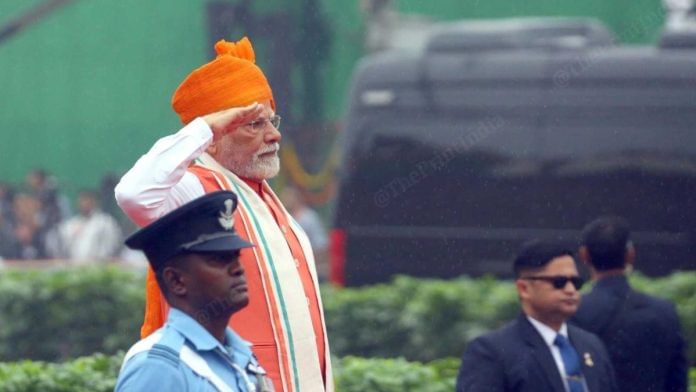New Delhi: A fully integrated security architecture linking every air defence system, including the planned Ballistic Missile Defence network and Project Kusha, or Extended Range Air Defence System, and space-based capabilities, is set to take shape under Project Sudarshan Chakra, which was announced by Prime Minister Narendra Modi Friday, ThePrint has learnt.
The project will include not just hard kill options, but also integrated soft kills with greater emphasis on cyber warfare, laser and directed energy weapons.
“Mission Sudarshan Chakra will enable a powerful weapon system, which will not only neutralise the enemy’s attack, but also hit back at the enemy many times over,” Modi said in his Independence Day address at the Red Fort.
He has set a 10-year time frame till 2035 for completion of the project. “The protective shield will keep expanding so that every citizen feels secure, and whatever kind of technology is used against India, our technology will prove to be superior.’
The prime minister said that Sudarshan Chakra, which incidentally is the Indian name for the S-400 Triumf air defence system, will be a fully modern system, with its research, development and manufacturing done entirely in India.
A source in the security establishment told ThePrint that the idea is more like that of the ‘Golden Dome’ announced by US President Donald Trump.
This new network, according to sources, will see both existing air defence systems and future plans integrated, providing a pan-India coverage against incoming ballistic missiles, hypersonics, fighter aircraft, loitering munitions and swarm drones among others. The systems will include those which provide strategic cover as well as those tasked for operational coverage.
Sources said that the exact details of the project announced by the prime minister are yet to be fully known, adding that this will include long range air defence missiles to indigenous long-range radars, and would be primarily led by the Defence Research and Development Organisation (DRDO) with strategic partners in both government and the private sector.
“There are multiple projects that India is currently working on, which are at various stages of completion. However, all of them need to be integrated and be capable of speaking to each other, which will then provide a fully integrated response to any kind of threat,” a source said.
One of the key elements of Project Sudarshan Chakra is Project Kusha, which is India’s own long-range air defence system. It will not be a system that will replace the S-400 Triumf, but will complement it.
“The Medium Range Surface to Air Missile (MRSAM) system that we use has a range of about 7-80 kilometres, and the next one available is the S-400, which has a range of up to 400 kilometres. This is where Project Kusha comes in. And yes, eventually Kusha will match the S-400 capabilities,” a source said, adding that Kusha is basically going to be MRSAM with extended boosters.
Another key element of Project Sudarshan Chakra will be the key ballistic missile interceptors that India has developed, sources added.
“The S-400 is basically our ballistic missile defence. However, we also have our indigenous BMD system which has been in the works for long. India already has interceptor missiles for both exo-atmospheric and endo-atmospheric interception. All of this has to be integrated into one security architecture, and this will include indigenous long range radars too,” a source told ThePrint.
Another aspect of the Sudarshan Chakra will be integrated space assets, not just for information, but also for round-the-clock surveillance of enemy operations.
It is understood that the Chinese were able to have a full-fledged overview of India’s military operations during Operation Sindoor, a capability that India is already working on.
(Edited by Mannat Chugh)
Also Read: ‘An expression of outrage’: Operation Sindoor front and centre in Modi’s Independence Day address






